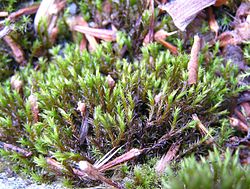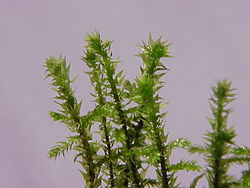Leaf position in mosses
For the description of the leaf positions in mosses ( Bryophyta ) a separate terminology has become established in many cases.
Angle of the leaves to the stem
- standing upright
- The leaves are sloping upwards towards the tip of the shoot. This leaf position is found in the majority of the moss .
- bulky protruding
- The leaves are more or less at a right angle from the stem.
- star-shaped
- In the case of sparsely leafed mosses, the youngest leaves, which are at the tip of the stems, are often an exception and lie more or less against the stems. Mosses, in which even these leaves protrude at a right angle, look characteristically star-shaped when viewed from above.

Schistidium apocarpum with upright leaves
|

Rhytidiadelphus triquetrus with sparsely protruding leaves
|
Orientation of the sheets
- two lines
- With this leaf position, which is also found in flowering plants , the leaves are in two rows on the stems. In this case, the leaf surfaces are usually all on one level. Most of the leafy liverworts appear to have two rows of leaves, but have a third row of small so-called sub - leaves on the underside of the stem .
- all-round
- In most deciduous mosses, the leaves are more or less evenly distributed on all sides. They are "all-round". This leaf position is due to the fact that the three-sided apex cell of the moss rotates in the course of the growth process.
- one-sided
- Many deciduous mosses have leaves on all sides of the stem, but they are all curved in the same direction. In most of these cases, all leaves are curved to the side, but there are also mosses in which the leaves are curved in the direction of the shoot or against the direction of the shoot. In the latter case, one speaks of curved back leaves. The type of curvature can be very different. Often it happens that narrowly lanceolate leaves are bent over their entire length. One then speaks of a sickle-shaped one-sided foliage. It is also not uncommon for the leaves to be curved in the shape of a hook, i.e. not bent over their entire length, but only in one place.
- flattened
- Although the leaves have grown more or less evenly on all sides of the stem, the leaf surfaces are rotated so that they all lie on the same plane. In many such species, the leaves themselves are asymmetrical.

Fissidens cristatus with two-line leaves.
|

Dicranum scoparium with unilateral leaves.
|

Rhytidiadelphus squarrosus with back-curved leaves.
|

Plagiothecium denticulatum with flattened foliage.
|
Others
- ruffled
- In some species of deciduous moss, especially in the Dicranaceae and Pottiaceae families , the leaves bend into small curls when they dry. One speaks of curled leaves. If this is not so pronounced, one speaks of bent leaves.
- worm-shaped
- If the leaves are hollow and lean forward so that the leading edge of each leaf touches the following leaves, a cavity is created under the leaves. The stem then lies like a closed tube. One speaks of worm-shaped or swollen foliage.

Tortella tortuosa with dry curled leaves.
|